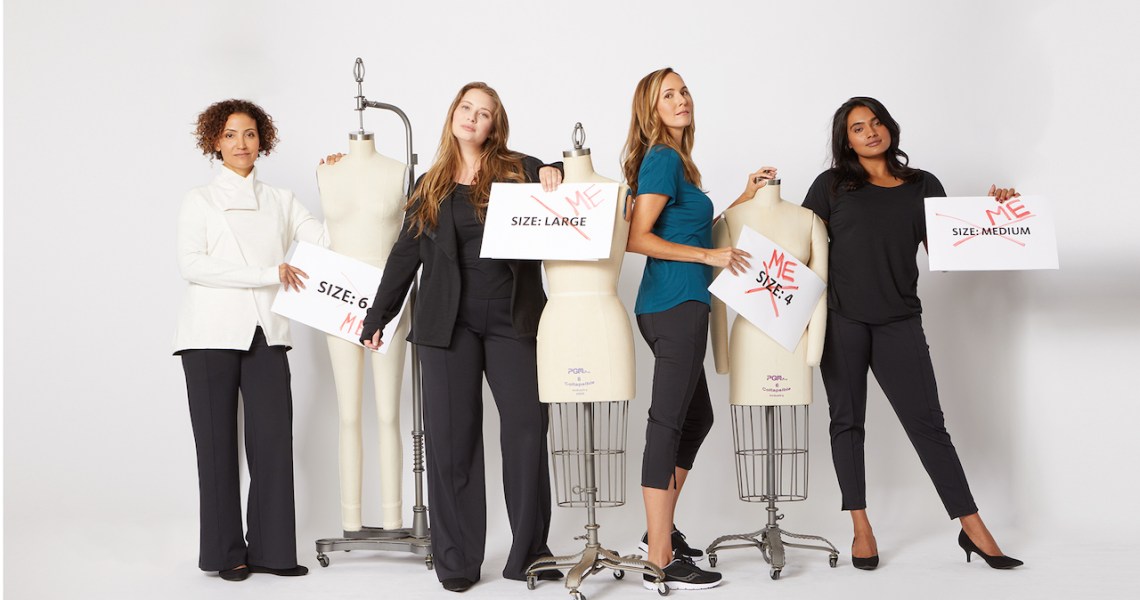From ThirdLove to Nordstrom, brands across the board are looking to crack size-inclusivity, extending their size range to cater to more diverse body shapes. Some companies are taking things a step further, investing in technology that helps create truly customizable clothing to fit each shopper to a T.
From RedThread to Measure & Made, made-to-measure fashion e-commerce brands are popping up left and right to help customers, mainly women, feel comfortable buying clothing online. In recent months, even Amazon has been building out a team that will reportedly help the company create perfect-fit clothing.
RedThread founder and CEO Meghan Litchfield said that prior to launching her made-to-measure clothing company in October 2018, she spent hours in fitting rooms looking for pants that fit her body type and ordered tons of clothes online, returning more than 80% of styles.
Litchfield spent 18 months working with 100 women of all shapes and sizes across the country, interviewing them about what styles they had the most fit issues with and taking their measurements. The brand also began working with technology partner Cala to scan each woman’s body, something that each customer can do when buying a RedThread product by taking a few selfies and uploading them through a data-encrypted text link sent by the brand to the shopper. From there, RedThread and Cala auto-generate a 3D body model and come up with perfect-fitting garments — mainly staples like wide-leg pants and T-shirts — for that shopper.
“The most interesting thing is that, out of all the items we’ve shipped, no two of them have been the same. Every single item we ship has truly been unique, which supports our original hypothesis with the 100 women that the sizing system is broken,” she said. “A lot of brands are adding more sizes, which I think is a nice solution around inclusivity, but it really doesn’t solve the core problem, which is that women’s bodies are all unique.” The brand does not list any sizes on its site, small or large, and will work with any customer to create the perfect fitting product.
Over eight months in business, Litchfield said the brand has a return rate of less than 4% and plans to expand its product range in the coming months.
Measure & Made, another made-to-measure e-commerce brand, launched in January. It uses Fitlogic technology, a measurement system developed by entrepreneur Cricket Lee that takes into account body shape as well as size, to create custom-fit jeans, pants and more. Fitlogic operates under the assumption (backed by the company’s own research) that 94.8% of women fall into 1 of 3 shapes: straight, hourglass and extremely curvy. Shoppers take a fit quiz, inputting their height, typical dress pant size and body shape, among other stats, to find out what their Fitlogic size is. Rather than whole numbers like 8 or 10, the system spits out a decimal like 8.2 or 10.3.
Ad position: web_incontent_pos1
“By focusing on shape and not just size, the [Fitlogic] system and its two-number decimal system give women the ability to experience what superior fit feels like by answering a few questions,” said Beatrice Purdy, president of Measure & Made. The brand has sold over 250,000 pairs of pants and jeans and sees a return rate that is 50% less than the national e-commerce average, said Purdy.
Not all brands have found success in the space. Take Zozo and the Zozosuit. The Zozosuit is a skintight, black suit covered in white dots that could essentially map the shape of a body to deliver the perfect fitting garment. The company launched in November 2017, and according to Quartz, it had over 1 million orders for the suit by May 2018. The company’s CEO, Yusaku Maezawa, later told analysts that while tons of consumers were ordering Zozosuits, not many were actually buying the clothes.
While brands like RedThread and Measure & Made are finding success in their early stages of creating custom clothing for women, the trend isn’t likely to catch on with major brands and retailers at this stage, said Ken Morris, principal at BRP Consulting.
“Bigger brands will hold back and wait, and let these smaller companies mature the technology. Then eventually, they will swoop in and take it up,” he said.
One of the biggest reasons why this custom-fit idea isn’t taking off with bigger companies is simply because it’s not so easy to scale. However, with the technology around today, Morris said he believes it’s easier for made-to-measure companies to scale versus “bespoke” or custom fashion brands, like menswear and custom-made suits that typically rely on people making things by hand, which can be both costly and time consuming.
Ad position: web_incontent_pos2
“Made-to-measure can scale because you can have 10 factories or 100 factories manufacturing things for you, but the real bespoke environment with multiple measurements and fittings — that can’t scale,” said Morris.
At RedThread, the company has 60-70% of a garment pre-made before a woman orders it. Once the company receives her measurements, it can tailor the garment by hand in its South San Francisco factory within a week. Having these “blanks” readily available enables the brand to turn garments around so quickly, Litchfield said.
“It makes a whole lot of sense,” Morris said. “You don’t have any wasted product, you’re getting someone to pay for the whole thing upfront, you don’t have any markdowns to deal with, there’s no over-inventory, you’re not out of stock. You avoid all of these problems that are traditional to retail.”
That’s not the case for all made-to-measure brands, though. For Measure & Made, the company sees a lot of backup inventory involved with the way it creates its garments.
“We carry triple the amount of inventory compared to other retailers because we carry all sizes in three shapes. This affects everything from production and storage, to selling and shipping. Other companies don’t want to take these types of risks because they involve more time and money,” said Purdy.




